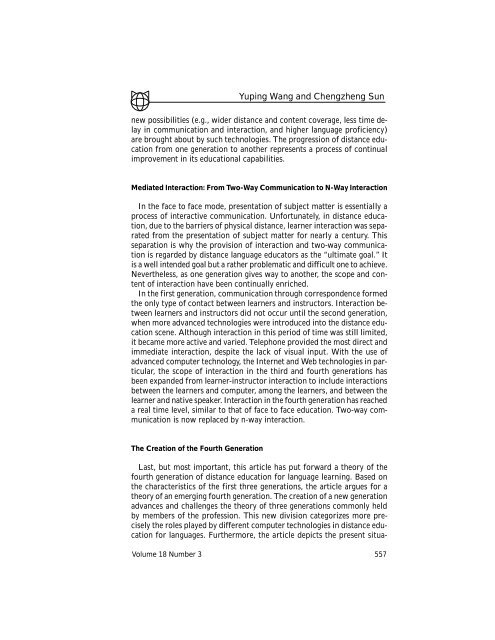Download this PDF file - Software @ SFU Library
Download this PDF file - Software @ SFU Library
Download this PDF file - Software @ SFU Library
You also want an ePaper? Increase the reach of your titles
YUMPU automatically turns print PDFs into web optimized ePapers that Google loves.
Yuping Wang and Chengzheng Sun<br />
new possibilities (e.g., wider distance and content coverage, less time delay<br />
in communication and interaction, and higher language proficiency)<br />
are brought about by such technologies. The progression of distance education<br />
from one generation to another represents a process of continual<br />
improvement in its educational capabilities.<br />
Mediated Interaction: From Two-Way Communication to N-Way Interaction<br />
In the face to face mode, presentation of subject matter is essentially a<br />
process of interactive communication. Unfortunately, in distance education,<br />
due to the barriers of physical distance, learner interaction was separated<br />
from the presentation of subject matter for nearly a century. This<br />
separation is why the provision of interaction and two-way communication<br />
is regarded by distance language educators as the “ultimate goal.” It<br />
is a well intended goal but a rather problematic and difficult one to achieve.<br />
Nevertheless, as one generation gives way to another, the scope and content<br />
of interaction have been continually enriched.<br />
In the first generation, communication through correspondence formed<br />
the only type of contact between learners and instructors. Interaction between<br />
learners and instructors did not occur until the second generation,<br />
when more advanced technologies were introduced into the distance education<br />
scene. Although interaction in <strong>this</strong> period of time was still limited,<br />
it became more active and varied. Telephone provided the most direct and<br />
immediate interaction, despite the lack of visual input. With the use of<br />
advanced computer technology, the Internet and Web technologies in particular,<br />
the scope of interaction in the third and fourth generations has<br />
been expanded from learner-instructor interaction to include interactions<br />
between the learners and computer, among the learners, and between the<br />
learner and native speaker. Interaction in the fourth generation has reached<br />
a real time level, similar to that of face to face education. Two-way communication<br />
is now replaced by n-way interaction.<br />
The Creation of the Fourth Generation<br />
Last, but most important, <strong>this</strong> article has put forward a theory of the<br />
fourth generation of distance education for language learning. Based on<br />
the characteristics of the first three generations, the article argues for a<br />
theory of an emerging fourth generation. The creation of a new generation<br />
advances and challenges the theory of three generations commonly held<br />
by members of the profession. This new division categorizes more precisely<br />
the roles played by different computer technologies in distance education<br />
for languages. Furthermore, the article depicts the present situa-<br />
Volume 18 Number 3 557
















